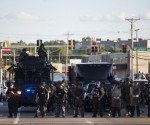Hersh: Everything We Were Told About Osama bin Laden’s Killing Was a Lie
The newest Seymour Hersh blockbuster in the London Review of Books has one big claim: virtually the entire story of Osama bin Laden’s death was an elaborate fiction.
Bin Laden wasn’t hiding out in Abbattobad, as we’ve been told—he was effectively under house arrest, placed there under guard by Pakistan’s security services with financial help from the Saudis. We didn’t track down his address through diligent intelligence work—a Pakistani informant ratted him out to the CIA in exchange for the $25 million reward. And we didn’t kill him in a firefight—he was abandoned by his Pakistani guards and gunned down in cold blood by U.S. troops. The whole operation was supposed to remain secret, with bin Laden’s death publicly chalked up to a drone strike, but an unexpected helicopter crash at the site of the raid forced the U.S. to concoct a complex symphony of lies. According to Hersh.
The article, if you believe its almost entirely anonymous sourcing (not that there’s anything wrong with anonymous sources!), casts the Obama White House’s account of the operation as a frantic and harried cover-up designed to valorize a “homicide,” as one anonymous commando put it. Though the Hersh account is by no means new—Hersh fails to credit her, but national security writer R.J. Hillhouse wrote a blog post in 2011 that included substantially the same claims, and generated some mainstream press accounts—his stature in the spook world and track record with previous stories means his account is getting traction.
Here are the U.S. lies about the raid, as catalogued by Hersh.
Bin Laden Wasn’t Buried at Sea
Since his killing in 2011, the U.S. government has maintained (and U.S. media has reported) that bin Laden was given a perfunctory naval funeral off the deck of an aircraft carrier, to prevent any gravesite from becoming a symbol of martyrdom. According to Hersh’s lengthy account of the assassination, bin Laden’s corpse never made it to the USS Carl Vinson, because it had been torn apart by machine gun fire at point blank range before the CIA took whatever shreds were left:
Some members of the Seal team had bragged to colleagues and others that they had torn bin Laden’s body to pieces with rifle fire. The remains, including his head, which had only a few bullet holes in it, were thrown into a body bag and, during the helicopter flight back to Jalalabad, some body parts were tossed out over the Hindu Kush mountains – or so the Seals claimed.
Hersh continues, “there never was a plan, initially, to take the body to sea, and no burial of bin Laden at sea took place…the retired official said that if the Seals’ first accounts are to be believed, there wouldn’t have been much left of bin Laden to put into the sea in any case.” This raises the possibility that the CIA remains in possession, literally, of Osama bin Laden’s head.
From Vanity Fair, November 2012:
“A navy photographer recorded the burial in full sunlight, Monday morning, May 2. One frame shows the body wrapped in a weighted shroud.”
From Hersh:
“It would be navy officers who came up with the “burial at sea” idea. Perfect. No body. Honourable burial following sharia law. Burial is made public in great detail, but Freedom of Information documents confirming the burial are denied for reasons of ‘national security’.”
There Was No Firefight, at All, During the Raid
From the New Yorker, August 2011:
“One SEAL unit had no sooner trod on the paved patio at the house’s front entrance when Abrar—a stocky, mustachioed man in a cream-colored shalwar kameez—appeared with an AK-47. He was shot in the chest and killed, as was his wife, Bushra, who was standing, unarmed, beside him.”
And from the New York Times, May 2011:
Abu Ahmed al-Kuwaiti, Osama bin Laden’s courier, opens fire from behind a door of the guesthouse. Commandos kill the courier. His wife is caught in the cross-fire and killed.
From Hersh:
“Aside from those that hit bin Laden, no other shots were fired.”
Pakistan Knew About, and Aided, the Operation
From the New Yorker:
“Obama decided against informing or working with Pakistan. ‘There was a real lack of confidence that the Pakistanis could keep this secret for more than a nanosecond,’ a senior adviser to the President told me.”
From Hersh:
“The most blatant lie was that Pakistan’s two most senior military leaders – General Ashfaq Parvez Kayani, chief of the army staff, and General Ahmed Shuja Pasha, director general of the ISI – were never informed of the US mission…Obama was anxious for reassurance that the US was going to get the right man. The proof was to come in the form of bin Laden’s DNA. The planners turned for help to Kayani and Pasha, who asked [Maj. Amir] Aziz to obtain the specimens.”
Bin Laden Was Gunned Down in a Hail of Bullets
From the New York Times, May 2011:
When the commandos reach Bin Laden’s room on the third floor, an AK-47 and a Makarov pistol are seen in arm’s reach of Bin Laden. A commando shoots Bin Laden in the left eye and chest, killing him.
From Hersh:
The later White House claim that only one or two bullets were fired into his head was ‘bullshit’, the retired official said. ‘The squad came through the door and obliterated him. As the Seals say, “We kicked his ass and took his gas.”’
An Informant Ratted bin Laden Out
From the New York Times, May 2011:
After nearly a decade of hunting Osama bin Laden, a breakthrough came in August of 2010 when Bin Laden’s most trusted courier was located and identified. What followed was eight months of painstaking intelligence work.
From Hersh:
The CIA did not learn of bin Laden’s whereabouts by tracking his couriers, as the White House has claimed since May 2011, but from a former senior Pakistani intelligence officer who betrayed the secret in return for much of the $25 million reward offered by the US.
There Was No “Trove” of al-Qaeda Documents In the bin Laden Compound
From the Washington Post, July 2011:
Toward the end of his decade in hiding, Osama bin Laden was spending as much time exchanging messages about al-Qaeda’s struggles as he was plotting ways for the terrorist network to reassert its strength.
From CNN, May 2012:
U.S. officials say that the documents found in the compound — about 6,000 worth — were written between September 2006 and April 2011 and were recovered from five computers, dozens of hard drives and more than 100 storage devices. The cache has been described as the single largest batch of senior terrorist material ever obtained.
From Hersh:
These claims were fabrications: there wasn’t much activity for bin Laden to exercise command and control over. The retired intelligence official said that the CIA’s internal reporting shows that since bin Laden moved to Abbottabad in 2006 only a handful of terrorist attacks could be linked to the remnants of bin Laden’s al-Qaida….
Despite all the talk,’ the retired official continued, there were ‘no garbage bags full of computers and storage devices. The guys just stuffed some books and papers they found in his room in their backpacks. The Seals weren’t there because they thought bin Laden was running a command centre for al-Qaida operations, as the White House would later tell the media. And they were not intelligence experts gathering information inside that house.’
If Hersh (and Hillhouse) are correct, then these outlets were basically republishing CIA fan fiction. Loyal Washingtonians have already begun reacting aggressively to Hersh’s story, and there will no doubt be be a series of volleys over “The Killing of Osama bin Laden.
By
Source: GAWKER
The Killing of Osama bin Laden
Seymour M. Hersh
It’s been four years since a group of US Navy Seals assassinated Osama bin Laden in a night raid on a high-walled compound in Abbottabad, Pakistan. The killing was the high point of Obama’s first term, and a major factor in his re-election. The White House still maintains that the mission was an all-American affair, and that the senior generals of Pakistan’s army and Inter-Services Intelligence agency (ISI) were not told of the raid in advance. This is false, as are many other elements of the Obama administration’s account. The White House’s story might have been written by Lewis Carroll: would bin Laden, target of a massive international manhunt, really decide that a resort town forty miles from Islamabad would be the safest place to live and command al-Qaida’s operations? He was hiding in the open. So America said.
The most blatant lie was that Pakistan’s two most senior military leaders – General Ashfaq Parvez Kayani, chief of the army staff, and General Ahmed Shuja Pasha, director general of the ISI – were never informed of the US mission. This remains the White House position despite an array of reports that have raised questions, including one by Carlotta Gall in the New York Times Magazine of 19 March 2014. Gall, who spent 12 years as the Times correspondent in Afghanistan, wrote that she’d been told by a ‘Pakistani official’ that Pasha had known before the raid that bin Laden was in Abbottabad. The story was denied by US and Pakistani officials, and went no further. In his book Pakistan: Before and after Osama (2012), Imtiaz Gul, executive director of the Centre for Research and Security Studies, a think tank in Islamabad, wrote that he’d spoken to four undercover intelligence officers who – reflecting a widely held local view – asserted that the Pakistani military must have had knowledge of the operation. The issue was raised again in February, when a retired general, Asad Durrani, who was head of the ISI in the early 1990s, told an al-Jazeera interviewer that it was ‘quite possible’ that the senior officers of the ISI did not know where bin Laden had been hiding, ‘but it was more probable that they did [know]. And the idea was that, at the right time, his location would be revealed. And the right time would have been when you can get the necessary quid pro quo – if you have someone like Osama bin Laden, you are not going to simply hand him over to the United States.’
This spring I contacted Durrani and told him in detail what I had learned about the bin Laden assault from American sources: that bin Laden had been a prisoner of the ISI at the Abbottabad compound since 2006; that Kayani and Pasha knew of the raid in advance and had made sure that the two helicopters delivering the Seals to Abbottabad could cross Pakistani airspace without triggering any alarms; that the CIA did not learn of bin Laden’s whereabouts by tracking his couriers, as the White House has claimed since May 2011, but from a former senior Pakistani intelligence officer who betrayed the secret in return for much of the $25 million reward offered by the US, and that, while Obama did order the raid and the Seal team did carry it out, many other aspects of the administration’s account were false.
‘When your version comes out – if you do it – people in Pakistan will be tremendously grateful,’ Durrani told me. ‘For a long time people have stopped trusting what comes out about bin Laden from the official mouths. There will be some negative political comment and some anger, but people like to be told the truth, and what you’ve told me is essentially what I have heard from former colleagues who have been on a fact-finding mission since this episode.’ As a former ISI head, he said, he had been told shortly after the raid by ‘people in the “strategic community” who would know’ that there had been an informant who had alerted the US to bin Laden’s presence in Abbottabad, and that after his killing the US’s betrayed promises left Kayani and Pasha exposed.
The major US source for the account that follows is a retired senior intelligence official who was knowledgeable about the initial intelligence about bin Laden’s presence in Abbottabad. He also was privy to many aspects of the Seals’ training for the raid, and to the various after-action reports. Two other US sources, who had access to corroborating information, have been longtime consultants to the Special Operations Command. I also received information from inside Pakistan about widespread dismay among the senior ISI and military leadership – echoed later by Durrani – over Obama’s decision to go public immediately with news of bin Laden’s death. The White House did not respond to requests for comment.
*
It began with a walk-in. In August 2010 a former senior Pakistani intelligence officer approached Jonathan Bank, then the CIA’s station chief at the US embassy in Islamabad. He offered to tell the CIA where to find bin Laden in return for the reward that Washington had offered in 2001. Walk-ins are assumed by the CIA to be unreliable, and the response from the agency’s headquarters was to fly in a polygraph team. The walk-in passed the test. ‘So now we’ve got a lead on bin Laden living in a compound in Abbottabad, but how do we really know who it is?’ was the CIA’s worry at the time, the retired senior US intelligence official told me.
The US initially kept what it knew from the Pakistanis. ‘The fear was that if the existence of the source was made known, the Pakistanis themselves would move bin Laden to another location. So only a very small number of people were read into the source and his story,’ the retired official said. ‘The CIA’s first goal was to check out the quality of the informant’s information.’ The compound was put under satellite surveillance. The CIA rented a house in Abbottabad to use as a forward observation base and staffed it with Pakistani employees and foreign nationals. Later on, the base would serve as a contact point with the ISI; it attracted little attention because Abbottabad is a holiday spot full of houses rented on short leases. A psychological profile of the informant was prepared. (The informant and his family were smuggled out of Pakistan and relocated in the Washington area. He is now a consultant for the CIA.)
‘By October the military and intelligence community were discussing the possible military options. Do we drop a bunker buster on the compound or take him out with a drone strike? Perhaps send someone to kill him, single assassin style? But then we’d have no proof of who he was,’ the retired official said. ‘We could see some guy is walking around at night, but we have no intercepts because there’s no commo coming from the compound.’
In October, Obama was briefed on the intelligence. His response was cautious, the retired official said. ‘It just made no sense that bin Laden was living in Abbottabad. It was just too crazy. The president’s position was emphatic: “Don’t talk to me about this any more unless you have proof that it really is bin Laden.”’ The immediate goal of the CIA leadership and the Joint Special Operations Command was to get Obama’s support. They believed they would get this if they got DNA evidence, and if they could assure him that a night assault of the compound would carry no risk. The only way to accomplish both things, the retired official said, ‘was to get the Pakistanis on board’.
During the late autumn of 2010, the US continued to keep quiet about the walk-in, and Kayani and Pasha continued to insist to their American counterparts that they had no information about bin Laden’s whereabouts. ‘The next step was to figure out how to ease Kayani and Pasha into it – to tell them that we’ve got intelligence showing that there is a high-value target in the compound, and to ask them what they know about the target,’ the retired official said. ‘The compound was not an armed enclave – no machine guns around, because it was under ISI control.’ The walk-in had told the US that bin Laden had lived undetected from 2001 to 2006 with some of his wives and children in the Hindu Kush mountains, and that ‘the ISI got to him by paying some of the local tribal people to betray him.’ (Reports after the raid placed him elsewhere in Pakistan during this period.) Bank was also told by the walk-in that bin Laden was very ill, and that early on in his confinement at Abbottabad, the ISI had ordered Amir Aziz, a doctor and a major in the Pakistani army, to move nearby to provide treatment. ‘The truth is that bin Laden was an invalid, but we cannot say that,’ the retired official said. ‘“You mean you guys shot a cripple? Who was about to grab his AK-47?”’
‘It didn’t take long to get the co-operation we needed, because the Pakistanis wanted to ensure the continued release of American military aid, a good percentage of which was anti-terrorism funding that finances personal security, such as bullet-proof limousines and security guards and housing for the ISI leadership,’ the retired official said. He added that there were also under-the-table personal ‘incentives’ that were financed by off-the-books Pentagon contingency funds. ‘The intelligence community knew what the Pakistanis needed to agree – there was the carrot. And they chose the carrot. It was a win-win. We also did a little blackmail. We told them we would leak the fact that you’ve got bin Laden in your backyard. We knew their friends and enemies’ – the Taliban and jihadist groups in Pakistan and Afghanistan – ‘would not like it.’…. Continue reading











